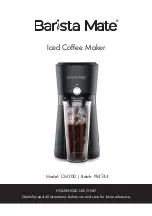
Fats
Fats tenderise, add flavour and extend shelf life of bread by retaining moisture. Shortening, margarine, butter or oil can be interchanged in
recipes. Loaves baked with these fats will vary slightly. Avoid low-calorie soft margarine as the higher water content can greatly affect loaf size
and texture.
salt
Salt controls the action of the yeast and adds flavour. Never omit salt from the dough. The amounts used are small but necessary. Without salt,
the bread may overrise or collapse.
sugars
Sugars provide food for the yeast as well as sweetness for the loaf and colour for the crust. Unless indicated in the recipe, use granulated white
sugar. Honey, brown sugar and molasses give bread a unique flavour and colour. Substituting one for the other may affect the final result.
Aspartame-based (not saccharin-based) granular sugar substitutes can be used. Substitute equal amounts for sugar in the recipe.
liquids
Liquids blend with the flour to produce an elastic dough. Milk gives a tender texture while water results in a crisper crust. Skimmed milk powder
and buttermilk powder increase the nutritional value while softening the texture. There is no need to reconstitute skimmed milk powder or
buttermilk powder. The use of these powders increases the number of recipes that may be used in combination with the timer function. Do not
use the timer function for recipes that require fresh milk. Buttermilk powder tends to blend better when added after the flour.
If you use milk instead of water and milk powder, use the same amount as the water. Homogenised, 2%, 1% or skimmed milk can be used in
recipes that require milk. Unsweetened fruit and vegetable juices can be used in amounts stated in the recipes. Read the labels of these juices to
make sure they do not contain added salt, sugar or sweeteners.
Eggs
Eggs add colour, richness and flavour. Always use large-size eggs fresh from the refrigerator. Do not use the timer function for recipes that require
fresh eggs.
cheese
Do not press cheese into the measuring spoon when you measure it. Low-fat cheeses may affect the loaf height and shape. Do not use the
timer function for recipes that require cheese
Yeast
Yeast, a tiny single-celled living organism, feeds on the carbohydrates in flour and sugar to produce carbon dioxide gas that makes bread rise.
Mixed with water and sugar, yeast wakes up during the kneading process and fills the dough with tiny bubbles that make it rise. Initial baking
causes the dough to rise higher until the yeast is inactivated. Exposure to air, heat and humidity decreases yeast activity. Always use yeast before
the expiry date. After opening, store yeast in the refrigerator in its original container, and use it within 6-8 weeks. There are 3 types of yeast
available - active dry, instant, and breadmaker yeast. Breadmaker yeast is a particularly active strain of yeast with increased levels of ascorbic acid
(vitamin C). It was developed specifically for use in breadmakers. To substitute active dry yeast or instant yeast for breadmaker yeast, increase the
amount stated in the recipe by ¼ teaspoon. For the best results, use the type of yeast specified in the recipe. Heat kills yeast. When you prepare
fillings, it is important that you let ingredients such as melted butter cool down before you use them. Keep yeast away from liquids, fats and salt
as they slow the activity. Do not increase the amount of yeast stated in the recipe.
Cinnamon and garlic both inhibit rising. If you use these ingredients, add them at the corner of the bread pan to make sure they do
not touch the yeast.
testing yeast activity
Dissolve 1 tsp sugar into ½ cup lukewarm water in a measuring cup. Sprinkle 2 tsp yeast over the surface. Stir gently. Let the mixture sit
undisturbed for 10 minutes. The mixture should be foamy with a strong smell of yeast. If not, purchase new yeast.
Bread mix
Bread mixes are available in many stores. Bread mix already includes flour, salt, sugar and yeast in the right amounts, so it is convenient to use. It
also comes in many different flavours and varieties. In most cases you just have to put water or milk and butter or oil in the bread pan as
indicated in the instructions on the bread mix package, and then add the bread mix.
measuring ingredients
Perfect loaves depend on the correct amount of each ingredient. Therefore it is important that you measure ingredients correctly. Even 1 or 2
incorrectly measured tablespoons (either to much or too little) make a big difference for the end result. Never measure ingredients over the
bread pan, as you may spill excess ingredients into the bread pan.
Tip: When you have to add e.g. 280ml water, add 1 cup (250ml)of water using the measuring cup and then add 2tbsp (30ml) of water using the
measuring spoon.
storage
Store flour in an airtight container in a cool, dry place. Exposed to heat or moisture, flour loses its strength and ability to rise. Flour absorbs
flavours quickly, so store it away from onions or garlic. Store bread, sealed tightly in a plastic bag or other airtight container, at room temperature
for 1 to 2 days. French-style breads should be stored in a paper bag or exposed to the air to retain their crisp crust. They are best eaten the
same day as baked
tools
measuring spoon
-
You can use the measuring spoon supplied to measure yeast, sugar, salt, milk powder and spices.
- Do not use measuring spoons to scoop up dry ingredients. Spoon dry ingredients lightly into the measuring spoon (Fig. 39).
- Heap the spoon, and then level it with the edge of a metal spatula or the straight edge of a knife. Do not press the ingredients into the
spoon, nor shake the spoon to level it (Fig. 40).
- The only ingredient that should be pressed into the measuring spoon is brown sugar. Press onto the sugar until it has the shape of the
measuring spoon.
measuring cup
-
Use a graduated transparent measuring cup for all liquids. Place the measuring cup on a flat surface and read the graduation at eye level. If
necessary, add or remove some liquid (Fig. 41).
Brush
- The brush can for instance be used to dampen the top of multi-shaper bread with water or to apply beaten egg to the top of buns.
EnglIsH
14
4222.005.0042.4.indd 14
02-06-10 14:29
Summary of Contents for HD9040
Page 1: ...HD9040 Additional Baking Information 4222 005 0042 4 indd 1 02 06 10 14 29 ...
Page 2: ...2 4222 005 0042 4 indd 2 02 06 10 14 29 ...
Page 4: ...4 4222 005 0042 4 indd 4 02 06 10 14 29 ...
Page 155: ...155 4222 005 0042 4 indd 155 02 06 10 14 29 ...
Page 156: ...156 4222 005 0042 4 indd 156 02 06 10 14 29 ...
Page 157: ...157 4222 005 0042 4 indd 157 02 06 10 14 29 ...
Page 158: ...158 4222 005 0042 4 indd 158 02 06 10 14 29 ...
Page 159: ...159 4222 005 0042 4 indd 159 02 06 10 14 29 ...
Page 160: ...160 4222 005 0042 4 indd 160 02 06 10 14 29 ...
Page 161: ...161 4222 005 0042 4 indd 161 02 06 10 14 29 ...
Page 162: ...162 4222 005 0042 4 indd 162 02 06 10 14 29 ...
Page 163: ...163 4222 005 0042 4 indd 163 02 06 10 14 29 ...
Page 164: ...164 4222 005 0042 4 indd 164 02 06 10 14 29 ...
Page 165: ...165 4222 005 0042 4 indd 165 02 06 10 14 29 ...
Page 166: ...166 4222 005 0042 4 indd 166 02 06 10 14 29 ...
Page 167: ...167 4222 005 0042 4 indd 167 02 06 10 14 29 ...
Page 168: ...168 4222 005 0042 4 indd 168 02 06 10 14 29 ...
Page 169: ...169 4222 005 0042 4 indd 169 02 06 10 14 29 ...
Page 170: ...170 4222 005 0042 4 indd 170 02 06 10 14 29 ...
Page 171: ...171 4222 005 0042 4 indd 171 02 06 10 14 29 ...
Page 172: ...172 4222 005 0042 4 indd 172 02 06 10 14 29 ...
Page 173: ...173 4222 005 0042 4 indd 173 02 06 10 14 29 ...
Page 174: ...174 4222 005 0042 4 indd 174 02 06 10 14 29 ...
Page 175: ...175 4222 005 0042 4 indd 175 02 06 10 14 29 ...
Page 176: ...176 4222 005 0042 4 indd 176 02 06 10 14 29 ...
Page 177: ...177 4222 005 0042 4 indd 177 02 06 10 14 29 ...
Page 179: ...179 41 4222 005 0042 4 indd 179 02 06 10 14 29 ...
Page 180: ...4222 005 0042 4 4222 005 0042 4 indd 180 02 06 10 14 29 ...















































